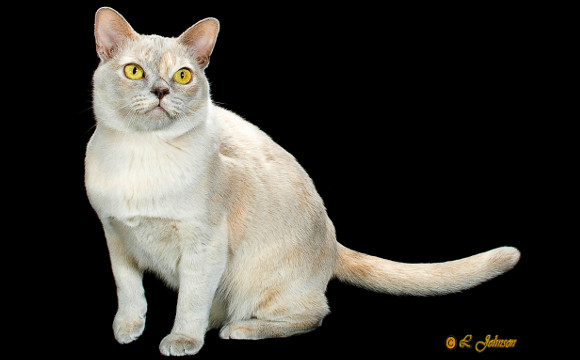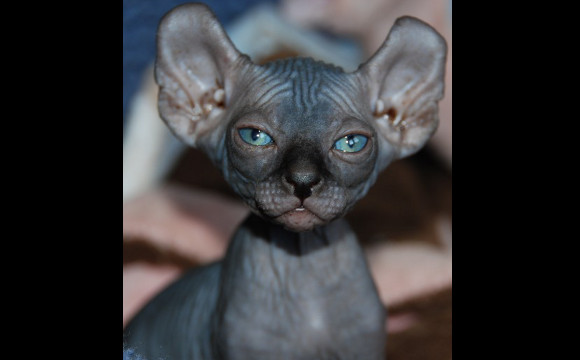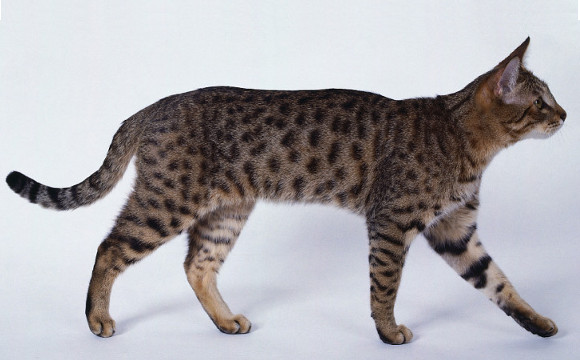History
The earliest records of a type resembling Burmese come from Thailand, then known as Siam. A series of 17 illustrated poems written in Siam during the period of the Ayutthaya, mention three types of cat which appear to correspond to known breeds. These were the Vichien Mat (Siamese), the Si-Sawat (Korat), and the Thong Daeng (Copper, now known as Burmese). These cats are thought to have remained in Thailand until it was invaded by the Burmese in the 18th century; returning soldiers may have taken the temple cats with them back to Burma. However, it is worth noting that cats from South East Asia often share characteristics and it is further breeding that gives them their distinct features.
In 1871, Harrison Weir organised a cat show at the Crystal Palace. Pair of Siamese cats was on display that closely resembled modern American Burmese cats in build, although Siamese in marking. This means that these cats were probably similar to the modern Tonkinese breed. After this, cat fancy began with cat clubs and cat shows forming, although it took many years for breeds to be worked-out and developed. The first Burmese cats in the late 19th century in Britain were considered Chocolate Siamese rather than a breed in their own right, and this view persisted for many years, encouraging cross-breeding between Burmese and Siamese and attempts to breed Burmese to more closely conform to the Siamese build. The breed slowly died out in Britain.
Dr. Joseph Cheesman Thompson imported Wong Mau, a brown female cat, into San Francisco in 1930. As had happened earlier, many breeders considered the cat simply to be a colour variant of the Siamese, but Dr Thompson considered the build sufficiently different to be something else. Without any male of a similar type, Wong Mau was bred with Tai Mau, a sealpoint Siamese from Thailand. Wong Mau was then bred with her son to produce dark brown kittens that were called Burmese cats. In 1936, the Cat Fancier’s Association granted recognition to the Burmese breed.
However, due to the extensive breeding with Siamese cats that had been used to increase the population, the original type was overwhelmed. CFA, the leading US cat registry, suspended recognition of the Burmese as a purebred cat on May 8, 1947. Other American cat registries continued to register the Burmese in America. In 1954, CFA lifted the suspension, and Gerstdale’s The Princess of Re-Ru and Hassayampa Spi-Dar of Regal were entered in the Foundation Record of CFA. In 1958, the unaffiliated breed club, United Burmese Cat Fanciers (UBCF) wrote a single standard that was to be used for judging ideal Burmese in all registries. The UBCF standard has remained essentially unchanged since its adoption. This standard is used in all American registries, but European regestries maintained their own standard. Recently, The International Cat Association (TICA) and CFA clubs have started holding shows in Europe and use the American breed standard for judging the Burmese in Europe. During the early period of breed development, it became clear that Wong Mau herself was genetically a hybrid between a Siamese and Burmese type. Such hybrids were later developed as a separate breed, known today as the Tonkinese.
The history of the breed unfolded differently in England. The breed was recognized by the United Kingdom Governing Council of the Cat Fancy (GCCF) in 1952. From about 1949 to 1956, the British Burmese population was being enriched with cats imported from America. The cats which fed the British breeding programme were of a variety of builds. By 1952, three generations had been produced in Britain and official recognition was granted by the GCCF and the breed was accorded the breed number 27. Until the late 1960s, the gene pool in Britain was very small, with most Burmese being descended from 6 initial imports and a Burmese/Chinese hybrid from Singapore. In 1969, more were brought over from Canada, and the genepool was widened.
The first blue Burmese was born in 1955 in England. This was to be followed by red, cream, and tortoiseshell kittens over the next couple of decades. Much effort was put in to remove banding patterns from the coats, and to decide whether these new colours counted as Burmese. Champagne coloured cats (known as “chocolate” in the UK) appeared in America, but breeding was impeded by the refusal of breed clubs to acknowledge that Burmese cats could be any colour other than Brown. In 1971, the first lilac kitten was born, being the latest solid colour introduced in Burmese. Throughout the 1970s, brown, chocolate (champagne), blue, and lilac tortoiseshell types were developed in England. In America, the chocolate (champagne), blue, and lilac (platinum) colors were accepted for registration as a separate breed, the Malayan in 1979. In 1984, the champagnes, platinums, and blues were accepted for registration as Burmese. Until 2010, CFA organized champagne, blue, and platinum Burmese into the “dilute division” and the sables into the “sable division,” where each division was judged as if it were a separate breed. CFA discontinued the divisions as of May 1, 2010. In 1989 a cinnamon breeding programme was started in Holland by Mrs Margaret Henderson and Mrs Dien de Kok. Successfully they bred the first Cinnamon Burmese in 1993: Bunny van d’Ekster, Burdie van d’Ekster and Kallistra Glenfiddich. The first Fawn was born in 1998 and was Kallistra Inarna. Cinnamon, Fawn, Caramel, and Apricot Burmese were also developed in New Zealand from a breeding programme initiated by geneticist Dr Rod Hitchmough. The first cinnamon Burmese born in New Zealand was Arsenios Cinnamon Dream Boy in 2001.
From the 1950s onwards, countries in the Commonwealth and Europe started importing Burmese cats from Britain. As a result, most countries based their Standard of Points for this breed on the British model, rather than the American.
Burmese cats have been instrumental in the development of other domestic cat breeds, including (but not limited to) the Tonkinese, the Bombay, and the Burmilla.
When it comes to personality, the European Burmese and the Burmese are in alignment. The European Burmese is energetic and friendly. He has the charm and determination of his Siamese ancestors, and enjoys conversation as much as that breed, but his voice is soft and sweet, belying his tendency to run the household with an iron paw sheathed in velvety fur. He is highly intelligent and seeks out human companionship, so he’s not best suited to a home where he will be left alone much of the day. If no humans will be around to engage his intellect, be sure he has the company of another pet. He gets along well with other cats and with dogs, but of course another Burmese (of either type) will be his best pal.
The European Burmese is about as curious as cats come. Expect him to explore your home thoroughly and know all of its nooks and crannies. He is playful and remains so into adulthood. Tease his clever mind with interactive toys, and teach him tricks that will allow him to show off for an audience. Besides sit, roll over, wave and come, he can learn to fetch a small toy or walk on a leash. With proper early conditioning, car rides and vet visits will be a breeze.
A European Burmese is a good choice if you don’t object to complete loss of privacy. This cat will want to be involved in everything you do, from reading the newspaper and working at the computer to preparing meals and watching television. He will, of course, sleep on the bed with you and may even snuggle under the covers. When you are sitting down, he will be in your lap or right next to you, waiting expectantly to be petted. You will be scolded if you ignore him. Guests will receive his full attention, and it is likely that he will win over even those who claim to dislike cats.
A female European Burmese is the very definition of queenliness. She likes attention and she likes to be in charge. Males are more restful, satisfied to fill a lap. Whichever you choose, it’s likely that you will soon find yourself yearning for another.
The accepted eye color for the breed is gold or yellow. The coat is known for being glossy, with a satin-like finish. As with most short-hairs, it requires no additional grooming. The shape of the British breed is more moderate but must not be Oriental, while the American breed is sturdier in build. Longer lived than most pedigree cats, they often reach 16 to 18 years of age. Burmese are a small to medium size breed and tend to be about 4–6 kg in weight.
Burmese are vocal like the Siamese but have softer, sweeter meows. They are very affectionate and enjoy company, being a people-oriented breed that form strong bonds with their owners and gravitate toward human activity. Burmese need a reasonable amount of human attention, are not as independent as other breeds and are not suited to being left alone for extended periods of time. The Cat Fanciers’ Association (CFA) breed information on the Burmese implies that all survival instinct of flight or fight seems to have been bred out of them. However, other sources note that, while rarely aggressive with humans, Burmese cats can defend themselves quite well against other cats, even those larger than themselves.
Burmese maintain kitten-like interests and energy throughout their adulthood. They have a number of dog-like characteristics, often learning to play fetch and tag. Burmese are good with children and dogs. They are suitable as an indoor breed of cat, will usually stay more affectionate if kept indoors and are comfortable travelling in cars.
- N/A Activity
- N/A Playfulness
- N/A Need for Attention
- N/A Affection
- N/A Need to Vocalize
- N/A Docility
- N/A Intelligence
- N/A Independence
- N/A Healthiness and Hardiness
- N/A Grooming needs
- N/A Good with children
- N/A Good with other pets













